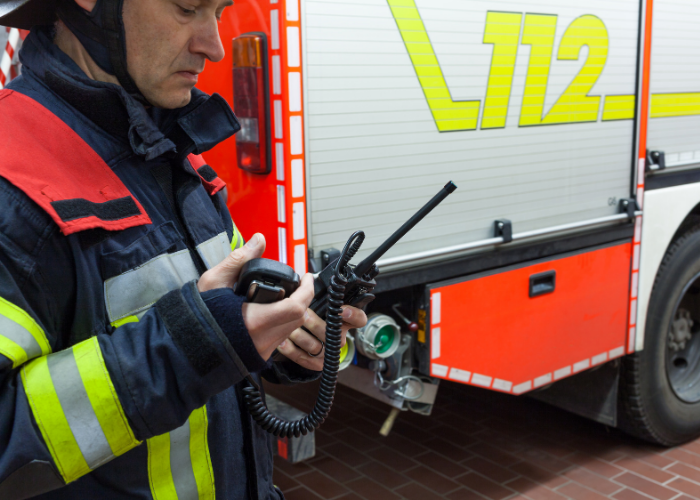Critical communications: today and tomorrow
- Categories: On-scene technology
Critical communications: what do we mean?
Critical communications include mobile, radio telecommunication systems and devices that must provide reliable and secure communication at all times. They are usually referred to as business critical and mission critical communications networks.
There is no overall standard classification for a mission or business critical network – however mission critical networks are those that are essential for some mission accomplishment (mostly public safety), and business critical networks serve businesses that cannot operate without reliable communications (transport, electricity, oil and gas production etc.).
When we talk about mission critical communications, it is paramount that first responders in the field are able to maintain connectivity to save our lives. Until recently, the dominant technologies used in networks for critical telecommunications were the ones that collectively are called LMR (Land Mobile Radio). These networks are designed for reliable voice communication and transmission of limited amounts of data. With the rapid development of technologies that enable the transmission of large amounts of data, including video transmission, such as LTE and 5G, broad-band networks for critical communications are also represented.

Many countries are moving towards broadband-based networks, as they provide increased data speeds and enhanced capacity. However, Land Mobile Radio still holds an important place in mission critical communications and has a proven track record for high availability and security.
Standardisation: a crucial element of critical comms
It is often said that there are three ‘Rs’ of the greatest importance for any critical telecommunications network: resilience, reliability and recovery. These are achieved through some more ‘Rs’ – redundancy and robustness.
To meet those requirements, there are technology standards that have been designed specifically with resilience and security at their core – these include TETRA, P25, Tetrapol and DMR. They are all well-established narrowband systems leveraged for both mission and business critical networks around the world.
Today, voice communications and low-speed data transmission no longer meet the needs of emergency services, whose users also require the transmission of large amounts of data, images and video materials. With the introduction of the NG112 systems, which will enable citizens to contact emergency services through video-call or text, and transfer other crucial data about the emergency situation, there is a clear need to transfer this information quickly and completely to and among the first responders in the field.
The Third Generation Partnership Project (3GPP) community has developed a set of standards for mission-critical functions for broadband networks (LTE, 5G). These cover push to talk, data and video features. Long-Term Evolution (LTE) is expected to bring increased data speeds and enhanced capacity when compared to Land Mobile Radio (TETRA and others). The aim of these standards is therefore to ensure that LTE provides these benefits without compromising on features such as high availability and security that are crucial for emergency services’ activities and have been well-proven by professional mobile radio technology. Critical communications have crossed the path from dedicated standards to become a part of the mainstream standards.
The decision to invest in a critical telecommunications network is a challenge for many emergency organisations. There are a range of technologies available, including simpler, cost-optimised digital systems, like DMR, through TETRA and P25, to 4G and 5G technologies. As is often the case, a combination of different technological solutions will be an option for many. However, whichever is chosen, it is important that it is ETSI/3GPP standardised. In this way, the investment is protected for many years to come.
Broadband roll-out: US, Europe and beyond…
Nationwide LTE systems for public safety are proceeding with the rollout of the Emergency Services Network (ESN) in the UK, First Net in the US and Safe Net in South Korea. In addition, regional and local 4G networks have been successfully installed for public safety in territories such as the Middle East.

The world leader of 4G/5G critical communications is First Net in the US. The First Net nationwide build-out continues to move forward with more than 13,000 public safety agencies and organisations using more than 1.5 million connections on the First Net network. In March 2020, the network achieved a key milestone with AT&T’s release of First Net Push to Talk (PTT). This feature allows a smartphone to be used like a radio. Emergency professionals can communicate in one-to-one or one-to-many calls with a single press of a button.
Over in the UK, ESMCP (Emergency Services Mobile Communication Programme) introduced a gradual, product based release schedule, in order to replace the Airwave TETRA network with broad-band. 2021 should see larger numbers of User Organisations starting to trial using the next release of Mission Critical Press to Talk functionality. Other countries have announced their plans for moving to broadband, especially in Scandinavia.
Transition to broadband: an evolutionary process
Countries need to consider the complexity of the purchasing procedures, the possible length of testing, and the future introduction of new operational modes. As The Critical Communications Association (TCCA) has highlighted in its Roadmap to broadband, whoever is planning to move to critical communications broadband should start their activities now.
Despite the revolutionary character of the new broadband technology for critical telecommunications, the transition to broadband is seen more as an evolutionary process. The adoption of Land Mobile Radio is still growing and will continue to do so until LTE becomes more established and proves its capability to meet all the specific critical voice communications requirements of emergency services.
It is also clear that a considerable number of agencies will remain using public cellular networks for their data requirements because of lack of private/hybrid LTE solutions, lack of spectrum and economic constraints, and they will continue to rely on Land Mobile Radio systems for critical voice communication.
In that sense, we expect that Land Mobile Radio systems – primarily TETRA and P25 – will work in parallel with broadband systems for many years to come.

Where to next?
TETRA has proved itself to be the “go-to” technology for critical communications users over the past 25 years and has an extensive range of well-tried and trusted functionalities which are required just as much today.
The development of an interface between the two technologies – LMR and LTE – is therefore an important task. 3GPP and ETSI are working hard to complete this as soon as possible. Interworking solutions between TETRA and Mission-critical Broadband systems will be particularly important over the medium term and will give emergency organisations the maximum choice in future migration plans whether temporary or on a long-term basis.

At the same time, it must be ensured that as many functionalities for critical communications are covered by 3GPP standards. Standards need to be developed not just for broadband networks, but also to continue improving the functionality and security of the TETRA system.
There are many trends to watch in the Critical Communications sector – 5G and cybersecurity are both hot topics, as is the range of challenges that nations are facing as they look to roll out critical broadband. We are living through a challenging time but there is much cause for optimism, and it’s a great time to be part of the critical communications ecosystem.
The opinions expressed are those of the author and do not necessarily represent the views of EENA. Articles do not represent an endorsement by EENA of any organisation.
Share this blog post on:
